The southern town of Elephantine was important in ancient times as a border town, later as a predecessor of modern Aswan. Originally it was called Abu, meaning ivory as well as elephant, testifying linguistically to the importance of the trade in ivory.
Excavations have been on-going since 1969 at the ancient town where settlements had existed since prehistoric times (about 3500 BCE) until the Islamic period. The site has been ideal for excavation since no modern buildings had been constructed over the ancient settlement and since the site was restricted in size.
|
Center: excavated area; right: Temple of SatetThe ruins include a variety of buildings located on the south end of Elephantine Island across from the modern city of Aswan. |

|
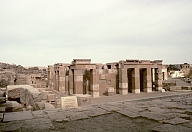
|
| |
|
| Archaeologists believe a sanctuary dedicated to the antelope goddess Satet existed at this site in about 3200 BCE. This temple was repeatedly reconstructed. In the Eighteenth Dynasty under the reigns of both Hatshepsut and Thutmosis III (c. 1490-1440 BCE) a larger temple to Satet was commissioned. However, later, during the Greco-Roman period stones from several temples on the site were used as building materials for later structures, often with only the foundation remaining of the earlier buildings.
Current excavations show the developments of this temple site through three thousand years, with the Sixth Dynasty temple rebuilt on the original location and with the Eighteenth Dynasty temple erected above it on a concrete platform. The temple design has a kind of ambulatory or peristyle. The ceiling was once supported by pillars with Hathor capitals. Views of the Temple of Satet and ambulatory |
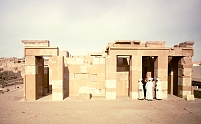
| 
|

|
| |
|
More than 500 blocks of the Satet Temple commissioned by Queen Hatshepsut have been recovered and reassembled, the reassembly made possible in part because the blocks had portions of reliefs engraved on them, thus providing a kind of huge jigsaw puzzle. Reliefs show the Queen worshipping various gods, with Satet chief among them. (See image on right; Satet wearing the crown with antelope horns is on the left side of that image.) Other deities include Amun and the ram god Khnum, depicted on the left in the left-hand image. Another tableau depicts a procession of boats on the Nile (center image).Blocks with reliefs |
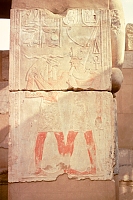
|
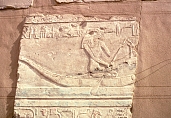
|
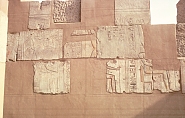
|


 Click here to go to the Egypt Index.
Click here to go to the Egypt Index. Click here to return to index of art historical sites.
Click here to return to index of art historical sites.
 Click here to return to index of artists and architects.
Click here to return to index of artists and architects.
 Click here to return to chronological index.
Click here to return to chronological index.
 Click here to see the home page of Bluffton College.
Click here to see the home page of Bluffton College.
